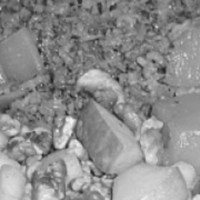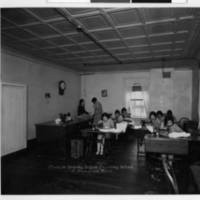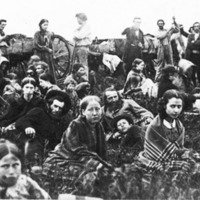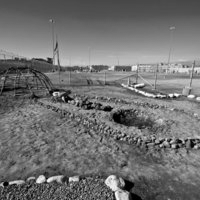Native American
The Dakota (Sioux) and Ojibwe (Anishinaabe, Chippewa) are the two contemporary peoples indigenous to the lands that became Minnesota, which is home to about 170,000 Native Americans. Mni Sota Makoče is how Dakota people refer to the place where the water reflects the sky. The Dakota are the easternmost peoples of the Oceti Sakowin or Seven Council Fires, and along with the Lakota, comprise the Great Sioux Nation, speaking different dialects of the same language. A band of Dakota called the Mdewakanton believe the confluence of the Mississippi and Minnesota Rivers, called Bdote, to be the site of their genesis. Today, the Twin Cities metro area sits on their homelands and Fort Snelling and Minneapolis-St. Paul International Airport lie very close to Bdote.
Ojibwe people tell a sacred story of migration from the Atlantic coast to the place "where food grows on the water," referring to manoomin, or wild rice, their traditional staple and sacred food. Their journey was foretold by seven prophets that emerged from the ocean claiming that they would perish if they did not move west and anticipating a future of loss and despair but also perseverance and regeneration. The Ojibwe refer to their homelands in northern Minnesota as Anishinaabe Akiing, translated either as "the people of the land" or "the land of the people" and reflecting a worldview, like that of the Dakota, that inverts typical notions of cause and effect. Instead of asking simply, "How do the people influence the land?" a more significant question is, "How does the land influence the people?"
Supernatural forces and the transcendent entity called Wakan Tanka for the Dakota and gichi-manidoo for the Ojibwe, translated as 'great spirit' or 'great mystery' are important in Minnesota Native American religion. Spiritual life places great importance on the land, water, and air, and Native American ways of life have been shaped by their environment for centuries. The waters of Minnesota are deeply important as providers of transportation, drinking water, and food, mostly wild rice and fish. Traditionally, the Dakota and Ojibwe lived in harmony with natural cycles, moving with the seasons and holding great respect for life. This deep knowledge and reverence of the natural world is partially reflected in the Midewiwin, or Grand Medicine Society, a vital aspect of Ojibwe religion. The Midewiwin is composed of spiritual leaders and healers who lead religious ceremonies, study sacred occult healing methods, and maintain a positive relationship with the planet. The Midewiwin lodge is a vital spiritual center for prayer, education, rites of passage, and gathering. Although it is less prevalent today than in the past, the Midewiwin has served as a fortress of faith, withstanding restrictions and assimilation to preserve fundamental aspects of Ojibwe spirituality for present generations.
The Dakota were pushed south as the Ojibwe moved into northern Minnesota through the Great Lakes in the late 17th and early 18th centuries, causing conflict but ultimately leading to good relations between the two groups. This peace was mediated by a mutual respect for religious and cultural difference and by diplomatic reconciliation based in the religious exchange of ceremonies and prayers. The 1825 Treaty of Prairie du Chien set boundaries between Dakota and Ojibwe land.
The future prophesied in Ojibwe oral history turned out to be accurate for both the Dakota and Ojibwe. As the French arrived in the Great Lakes region in the 1600s, Native Americans proved essential to the fur trade. Later, in the early 19th century, Christian missions were bent on converting native peoples. Protestant missionaries sought to root out Dakota and Ojibwe values with hymns translated into their respective languages, but within the limits of Christianization, the Ojibwe made this singing their own ritual, a practice that continues today at funeral wakes. In a series of treaties in the mid-19th century, both the Dakota and Ojibwe were compelled to cede their traditional homelands to the expanding U.S. in exchange for payments that rarely came. This deeply affected traditional lifestyles and cultural and spiritual connections to sacred places and landscapes. In 1851, the Dakota were confined to a reservation along the Minnesota River that extended for ten miles on either side; they lost the northern stretch in 1858. Faced with confinement to a small territory, failing crops, and broken promises, the Dakota rose up out of desperation in 1862, triggering the U.S.-Dakota War. The outcome was a forced winter march, the largest mass execution in American history, and the expulsion of all Dakota peoples from their homelands and into outlying states, completely severing the connection between land and people. Similarly, Ojibwe homelands were gradually reduced to several reservations. Between 1883 and 1934, reservation life was governed by administrative laws known as the Civilization Regulations, sometimes called the Religious Crimes Code, under which Dakota and Ojibwe peoples could be jailed and fined for participating in the Sun Dance, funerary give-away feasts, and traditional medicine and healing ceremonies, thus denying them the freedom of religion. Forcible English-only boarding school education from the 1870s through the 1930s sought quite effectively to dissolve ties of kinship, land, culture, language, and religion, sowing intergenerational historical trauma that continues to afflict many native peoples in Minnesota today.
While the Dakota and Ojibwe both experienced immense losses, in the 20th and 21st centuries they have been active in reviving their language, culture, and religion. In 1968, the American Indian Movement (AIM) was formed in Minneapolis by two Ojibwe leaders; the AIM grew its presence and scope to reconnect Dakota and other native peoples with their language, spirituality, and kin, which led to national legislation in the areas of education, self-determination, religious freedom, and language. Particularly important was the AIM's emphasis on reinvigorating their spirituality, which would help native peoples combat the causes of their suffering. The National Indian Education Association was formed in Minnesota in 1969 to combat low educational attainment rates among Native American youth. Wherever they live, the Dakota and Ojibwe continue to live in profound relationship to homelands and sacred places both on and beyond reservation boundaries despite centuries of conflict and hardship. Their endurance speaks to the strength of cultures, languages, religions, and peoples that refused to be extinguished.
Pipestone

Among the most sacred Native American places in Minnesota are the Pipestone quarries in the southwestern corner of...
Unpublished Exhibits
Native Religiosity in Minneapolis

This exhibit explores the ways that Native American culture and religiosity manifest in the urban spaces of Minneapolis, Minnesota. It...
Pipestone Indian Training School

Indian policy, American myth, and Native religion collide at the Pipestone Indian Industrial Training School, a federal Indian boarding school...
Eagle Feather Protection

Dakota Language Revitalization

Exhibit on revitalization of the Dakota language in Minnesota, created November 2015.
Ojibwe Language Revitalization

An overview and history of the Ojibwe people's struggle to maintain cultural identity and their current push towards revitalization of...
Lacrosse

A curated exhibit showing how the sport of lacrosse has a deep cultural and spiritual tradition among Native Americans. From...
Lake Superior as a Cultural Resource

An overview of the cultural significance of Lake Superior and the importance of sites on its shores to the Ojibwe...
Eagle Rock Mining Controversy

The controversy over Eagle Mine, a nickle and copper sulfide mine located in Michigan's upper peninsula, and Eagle rock, an...
Native and Christian in Minneapolis - St. Paul

Understanding what it means to be native and Christian
Native American Religious Freedom at Stillwater Correctional Facility, MN

